

Sea ice is frozen seawater that floats on the ocean surface. It forms in both the Arctic and the Antarctic in each hemisphere’s winter; it retreats in the summer, but does not completely disappear. This floating ice has a profound influence on the polar environment, influencing ocean circulation, weather, and regional climate.
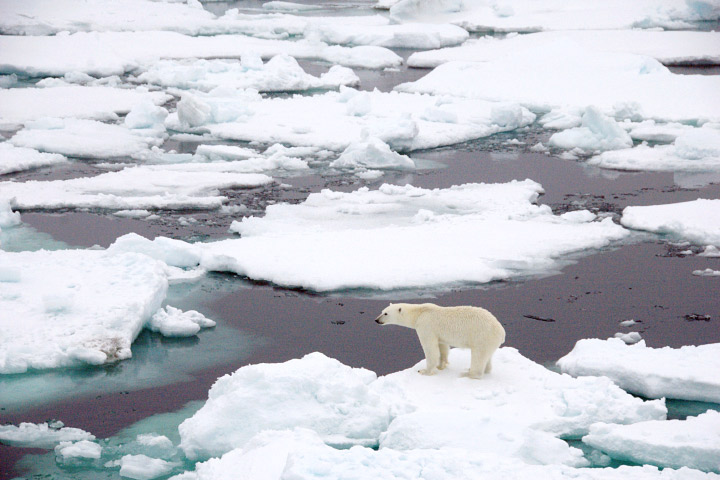
As ice crystals form at the ocean surface, they expel salt, which increases the salinity of the underlying waters. This cold, salty water is dense and can sink to the ocean floor, where it flows back toward the equator. The sea ice layer also restricts wind and wave action near coastlines, lessening coastal erosion and protecting ice shelves. Sea ice also creates an insulating cap across the ocean surface, which reduces evaporation and heat loss to the atmosphere. As a result, the weather over ice-covered areas tends to be colder and drier than it would be without ice.
Sea ice also plays a fundamental role in polar ecosystems. When the ice melts in the summer, it releases nutrients into the water, stimulating the growth of phytoplankton, the center of the marine food web. As the ice melts, it exposes ocean water to sunlight, spurring photosynthesis in phytoplankton. When ice freezes, the underlying water gets saltier and sinks, mixing the water column and bringing nutrients to the surface. The ice itself is habitat for animals such as seals, Arctic foxes, polar bears, and penguins.
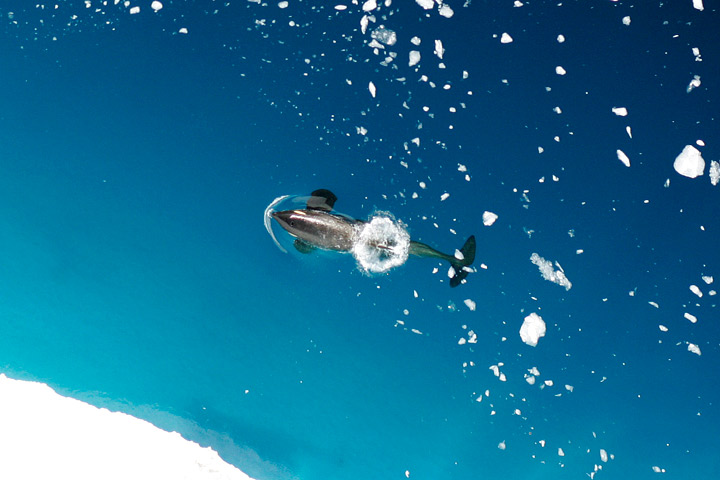
The influence of sea ice on the Earth is not just regional; it’s global. The white surface reflects far more sunlight back to space than ocean water does. (In scientific terms, ice has a high albedo.) Once sea ice begins to melt, a self-reinforcing cycle often begins. As more ice melts and exposes more dark water, the water absorbs more sunlight. The sun-warmed water then melts more ice. Over several years, this positive feedback cycle (the ice-albedo feedback) can influence global climate.
Contrary to some public misconceptions, sea ice does not influence sea level. Because it is already floating in the ocean, sea ice is already displacing its own weight. Melting sea ice won’t raise ocean levels any more than melting ice cubes will cause a glass of ice water to overflow.
When seawater begins to freeze, it forms tiny crystals just millimeters wide called frazil. How the crystals coalesce into larger masses of ice depends on whether the seas are calm or rough. In calm seas, the crystals form thin sheets of ice, nilas, so smooth that they have an oily or greasy appearance. These wafer-thin sheets of ice slide over each other and form rafts of thicker ice. In rough seas, ice crystals converge into slushy pancakes. These pancakes slide over each other to form smooth rafts, or they collide into each other, creating ridges on the surface and keels on the bottom.
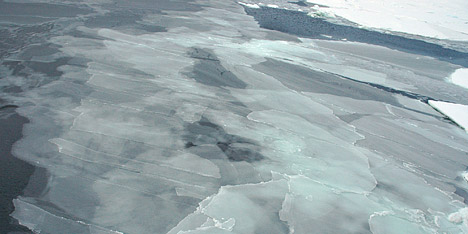

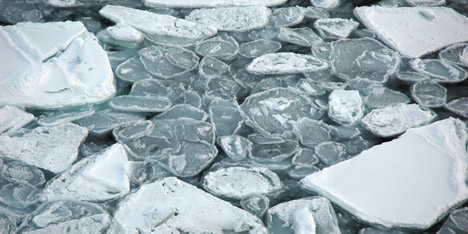

Some sea ice holds fast to a coastline or the sea floor—“fast ice”—while pack ice drifts with winds and currents. Because pack ice is dynamic, pieces can collide and form much thicker ice. Leads—narrow, linear openings ranging in size from meters to kilometers—continually form and disappear.
Larger and more persistent openings, polynyas, are sustained by upwelling currents of warm water or steady winds that blow the ice away from a spot as quickly as it forms. Polynyas often occur along coastlines when winds blow persistently offshore.
As water and air temperatures rise each summer near the Poles, some sea ice melts. Differences in geography and climate cause Antarctic sea ice to melt more completely in the summer than Arctic sea ice.
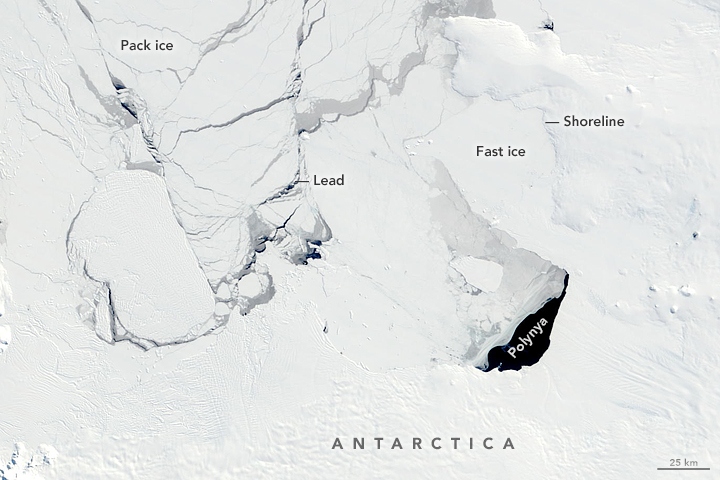
Ice that survives the summer melt season may last for years. For ice to thicken, the ocean must lose heat to the atmosphere. But the ice also insulates the ocean like a blanket. Eventually, the ice gets so thick that no more heat can escape. Once the ice reaches this thickness—3 to 4 meters (10 to 13 feet)—further thickening isn’t possible except through collisions and ridge-building.
Multiyear ice increasingly loses salt and hardens each year that it survives the summer melt. In contrast to multiyear ice, first-year ice is thinner, saltier, and more prone to melt in the subsequent summer. As of March 2015, multiyear ice accounted for 31 percent of the ice cover. The rest was first-year ice.
Dating back to A.D. 870, intermittent records assembled by the Vikings record the number of weeks per year that ice occurred along the north coast of Iceland. Other, scattered records of Arctic sea ice date back to the mid-1700s, when sailors kept notes on Northern Hemisphere shipping lanes. Global air temperature records date back to the 1880s and can offer a stand-in (proxy) for Arctic sea ice conditions; but such temperature records were initially collected at just 11 locations. Russia’s Arctic and Antarctic Research Institute has compiled ice charts since 1933.
Today, scientists studying Arctic sea ice trends can rely on a fairly comprehensive record dating back to 1953. They use a combination of satellite records, shipping records, and ice charts from several countries.
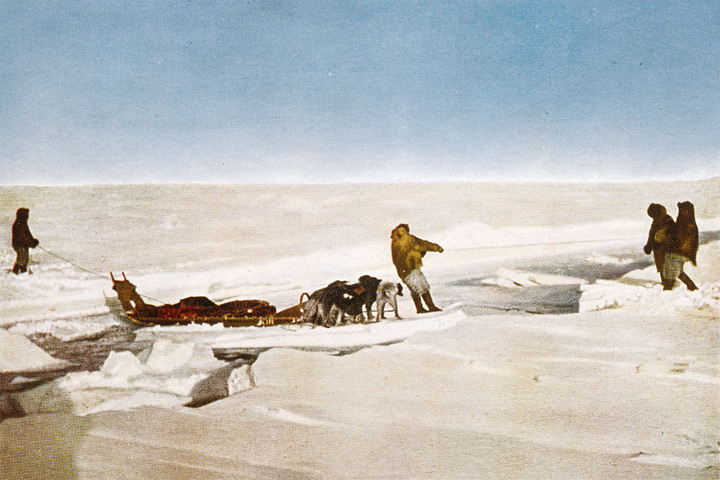
Early records of sea ice cover come from explorers like Robert Peary, who attempted to reach the North Pole in 1909. But expeditions were sporadic and only surveyed their immediate environment, so their records are far from comprehensive. (Image courtesy Library of Congress Prints and Photographs Division.)
In the Antarctic, data prior to the satellite era are even more sparse. To extend the historical record of Southern Hemisphere sea ice back in time, scientists have been investigating two types of proxies. One reference is the records kept by Antarctic whalers since the 1930s, which document the location of all whales caught. Because whales tend to congregate and feed near the sea ice edge, their locations could be a proxy for ice extent.
A second proxy is the detection of phytoplankton-derived organic compounds in Antarctic ice cores. Since phytoplankton grow most abundantly along the edges of the ice, the concentration of sulfur-containing compounds has been proposed as an indicator of how far the ice edge extended from the continent. Currently, only the satellite record is considered sufficiently reliable for studying Antarctic sea ice trends.
Since 1979, a collection of satellites has provided a continuous, nearly complete record of Earth’s sea ice cover. Valuable data are collected by satellite sensors that observe the microwaves emitted by the ice surface. Unlike visible light, the microwave energy radiated by ice passes through clouds. This means it can be measured year-round, even through the long polar night.
The continuous sea ice record began with the Scanning Multichannel Microwave Radiometer (SMMR) on the Nimbus-7 satellite (1978-1987) and continued with the Special Sensor Microwave/Imager (SSM/I) and the Special Sensor Microwave Imager Sounder (SSMIS) on Defense Meteorological Satellite Program (DMSP) satellites (1987 to present). The Advanced Microwave Scanning Radiometer–for EOS (AMSR-E) on NASA’s Aqua satellite also contributed data (2002-2011), a record that was extended with the 2012 launch of the Advanced Microwave Scanning Radiometer 2 (AMSR2) on JAXA’s GCOM-W1 satellite.
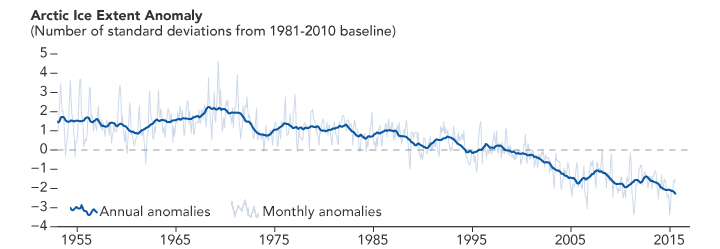
Reliable records of Arctic sea ice began in 1953, and satellites have offered a near-continuous record since 1979. The plot above shows sea ice anomalies—how much Arctic sea ice cover was above or below the norm. (NASA Earth Observatory graph by Joshua Stevens, using NSIDC data provided by Walt Meier/NASA Goddard.)
Because ocean water emits microwaves differently than sea ice, ice “looks” different to a satellite sensor. These observations are processed into digital picture elements, or pixels, with each representing a square of 25 kilometers by 25 kilometers. Scientists estimate the amount of sea ice in each pixel.
There are two ways to express Earth's total polar ice cover: ice area and ice extent. To estimate area, scientists calculate the percentage of sea ice in each pixel, multiply by the pixel area, and add up the amounts. To estimate ice extent, scientists set a threshold percentage, and count every pixel that meets or exceeds that threshold as “ice-covered.” The National Snow and Ice Data Center, one of NASA’s Distributed Active Archive Centers, monitors sea ice extent using a threshold of 15 percent.
The threshold–based approach may seem less accurate, but it has the advantage of being more consistent. When scientists are analyzing satellite data, it is easier to say whether there is or isn’t at least 15 percent ice cover in a pixel than it is to say, for example, whether the ice cover is 70 percent or 75 percent. By reducing the uncertainty in the amount of ice, scientists can be more certain that changes over time are real.
Beyond measuring ice coverage, satellites can also help scientists get a better handle on thickness. In 2010, the European Space Agency launched the CryoSat-2 satellite, which carries the Synthetic Aperture Interferometric Radar Altimeter (SIRAL). Data from this instrument are converted into maps of sea ice thickness—a useful tool for tracking change over time and for monitoring winter season ice growth.
Researchers also monitor sea ice using aircraft. In the summer of 2016, for example, NASA’s Operation IceBridge mapped the extent, frequency, and depth of melt ponds that form on top of the sea ice during the melt season. The number of melt ponds that form early in the season can affect the minimum extent reached by sea ice in September. Operation IceBridge has monitored sea ice during late winter since 2009.
Arctic sea ice occupies an ocean basin mostly enclosed by land. Because there is no landmass at the North Pole, sea ice extends all the way to the pole, making the ice subject to the most extreme oscillations between wintertime darkness and summertime sunlight. Likewise, because the ocean basin is surrounded by land, ice has less freedom of movement to drift into lower latitudes and melt. Sea ice also forms in areas south of the Arctic Ocean in winter, including the Sea of Okhotsk, the Bering Sea, Baffin Bay, Hudson Bay, the Greenland Sea, and the Labrador Sea.

The Bering Strait is one of the few outlets through which sea ice exits the Arctic Ocean. (NASA Earth Observatory image by Joshua Stevens and George Riggs using data from Terra MODIS.)
Arctic sea ice generally reaches its maximum extent each March and its minimum extent each September. This ice has historically ranged from roughly 14-16 million square kilometers (about 5.4-6.2 million square miles) in late winter to roughly 7 million square kilometers (about 2.7 million square miles) each September. In recent years, however, those numbers have been much lower.
On time scales of years to decades, the dominant cause of atmospheric variability around the North Pole is the Arctic Oscillation. The AO is an atmospheric seesaw in which air masses shift between the polar regions and the mid-latitudes. The shifting can intensify, weaken, or move the location of semi-permanent low and high-pressure systems. These changes influence the strength of the prevailing westerly winds and the track that storms tend to follow.

The minimum Arctic sea ice extent occurs in September. The maximum is in February or March. Arctic sea ice maxima and minima have been shrinking for three decades. (NASA Earth Observatory maps by Joshua Stevens, based on AMSR2-E data from NSIDC.)
During the “positive” phase of the Arctic Oscillation, winds intensify, which increases the size of leads in the ice pack. The thin, young ice that forms in these leads is more likely to melt in the summer. The strong winds also tend to flush ice out of the Arctic through the Fram Strait. During “negative” phases of the oscillation, winds are weaker. Multiyear ice is less likely to be swept out of the Arctic basin into the warmer waters of the Atlantic.
However, in recent years, the relationship between the Arctic Oscillation and summer sea ice extents has weakened. For example, a strong negative phase in the winters of 2009 and 2010 was not enough to maintain high levels of ice cover. Clearly some other factors can override the relationship.
In September 2015, Arctic sea ice reached a minimum extent of 4.41 million square kilometers (1.7 million square miles)—the fourth lowest in the satellite record. The ice then grew during the winter months and reached its annual maximum extent in March 2016, measuring 14.52 million square kilometers (5.61 million square miles). By September 2016, sea ice dropped to 4.14 million square kilometers (1.6 million square miles), the second lowest extent of the satellite era.
The record lowest minimum occurred in September 2012 when sea ice plummeted to 3.41 million square kilometers (1.32 million square miles). That was well below the previous record of 4.17 million square kilometers (1.61 million square miles) set in 2007, when Arctic sea ice extent broke all prior records by mid-August, more than a month before the end of melt season. Since the mid-2000s, low minimum extents in the Arctic have become the “new normal.”
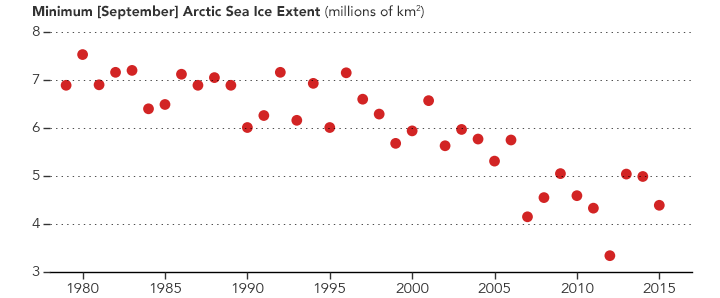
Between 1979 and 2015, the average monthly extent for September declined by 13.4 percent per decade. In every geographic area, in every month, and every season, Arctic sea ice extent is lower today than it was during the 1980s and 1990s.
Natural variability and global warming both appear to have played a role in this decline. The Arctic Oscillation’s strongly positive mode through the mid-1990s flushed thicker, older ice out of the Arctic, replacing multiyear ice with first-year ice that is more prone to melting. After the mid-1990s, the AO was often neutral or negative, but sea ice failed to recover. Instead, a pattern of steep Arctic sea ice decline began in 2002. The AO likely triggered a phase of accelerated melt that continued into the next decade because of unusually warm Arctic air temperatures.
| Year | Average Minimum Extent (millions of km2) | Extent Relative to 1981-2010 Average (millions of km2) | Difference from 1981-2010 Average (percent) |
|---|---|---|---|
| 2002 | 5.95 | -0.55 | -8.53 |
| 2003 | 6.13 | -0.37 | -5.76 |
| 2004 | 6.04 | -0.46 | -7.15 |
| 2005 | 5.56 | -0.94 | -14.53 |
| 2006 | 5.91 | -0.59 | -9.15 |
| 2007 | 4.29 | -2.22 | -34.05 |
| 2008 | 4.72 | -1.79 | -27.44 |
| 2009 | 5.38 | -1.13 | -17.29 |
| 2010 | 4.92 | -1.59 | -24.37 |
| 2011 | 4.61 | -1.90 | -29.13 |
| 2012 | 3.62 | -2.89 | -44.35 |
| 2013 | 5.35 | -1.16 | -17.76 |
| 2014 | 5.28 | -1.23 | -18.83 |
| 2015 | 4.63 | -1.88 | -28.82 |
Many global climate models predict that the Arctic will be ice free for at least part of the year before the end of the 21st century. Some models predict an ice-free Arctic by mid-century. Depending on how much Arctic sea ice continues to melt, the ice could become extremely vulnerable to natural variability in cycles such as the Arctic Oscillation.

Arctic sea ice cover peaks each year in March, and reaches its minimum in September. In 2012 arctic ice reached the lowest extent ever recorded, well below the historical average (blue dashed line). (Earth Observatory graph by Joshua Stevens, based on data from the National Snow and Ice Data Center.)
Declining sea ice will lead to a loss of habitat for seals and polar bears; it also should increase encounters between polar bears and humans. Indigenous peoples in the Arctic have already described changes in the health and numbers of polar bears.
As sea ice retreats from coastlines, wind-driven waves—combined with thawing permafrost—will likely lead to more rapid coastal erosion. Other potential impacts include changed weather patterns. This is an area of active research, as scientists try to tease out the possible links between sea ice loss and mid-latitude weather patterns.
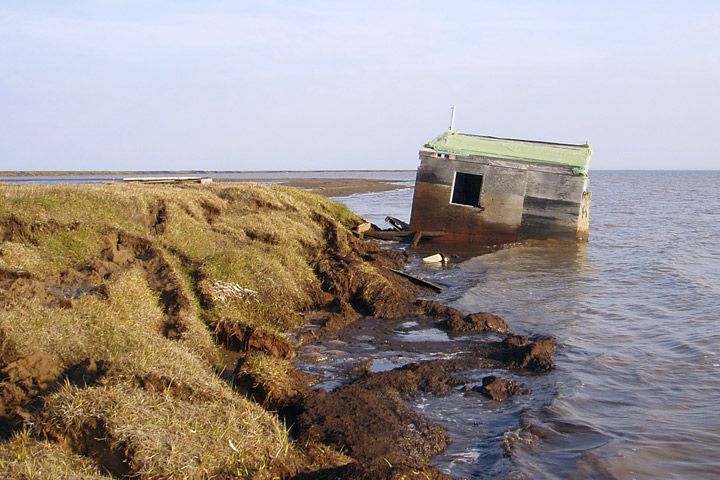
The loss of sea ice exposes shorelines to the full force of wind and waves, resulting in rapid erosion. This cabin fell into the Beaufort Sea, a region where some coastlines retreated more than 24 meters (80 feet) in 2007. (Photograph courtesy Benjamin Jones, USGS.)
Some researchers have hypothesized that melting sea ice could interfere with ocean circulation. In the Arctic, ocean circulation is driven by the sinking of dense, salty water. Fresh meltwater coming primarily from the Greenland Ice Sheet could interfere with ocean circulation at high latitudes, slowing it down. Changes in the location and timing of sea ice growth—where the dense salty waters are formed and then sink to the bottom—may also be an important factor.
The Antarctic is in some ways the opposite of the Arctic. The Arctic is an ocean basin surrounded by land, with the sea ice corralled in the coldest, darkest part of the Northern Hemisphere. The Antarctic is a continent surrounded by ocean. Whereas Northern Hemisphere sea ice can extend from the North Pole to a latitude of 45°N (along the northeast coasts of Asia and North America), most of the ice is found above 70°N. Southern Hemisphere sea ice does not get that close to the South Pole; it fringes the continent and reaches to 55°S latitude at its greatest extent.

Sea ice around Antarctica peaks in September and reaches a minimum in February. Roughly 15 million square kilometers of ice melt and freeze during the annual cycle. (NASA Earth Observatory graph by Joshua Stevens, based on data from the National Snow and Ice Data Center.)
Because of this geography, Antarctic sea ice coverage is larger than the Arctic’s in winter, but smaller in the summer. Total Antarctic sea ice peaks in September—the end of Southern Hemisphere winter—historically rising to an extent of roughly 17-20 million square kilometers (about 6.6-7.7 million square miles). Ice extent reaches its minimum in February, when it dips to roughly 3-4 million square kilometers (about 1.2-1.5 million square miles).
To study patterns and trends in Antarctic sea ice, scientists commonly divide the ice pack into five sectors: the Weddell Sea, the Indian Ocean, the western Pacific Ocean, the Ross Sea, and the Bellingshausen and Amundsen seas. In some sectors, it is common for nearly all the sea ice to melt in the summer.
Antarctic sea ice is distributed around the entire fringe of the continent—a much broader area than the Arctic—and it is exposed to a broader range of land, ocean, and atmospheric influences. Because of the geographic and climatic diversity, Antarctic sea ice is more variable from year to year and climate oscillations don’t affect ice in all sectors the same way. For these reasons, it is more difficult to generalize the influence of climate patterns to the entire Southern Hemisphere ice pack.
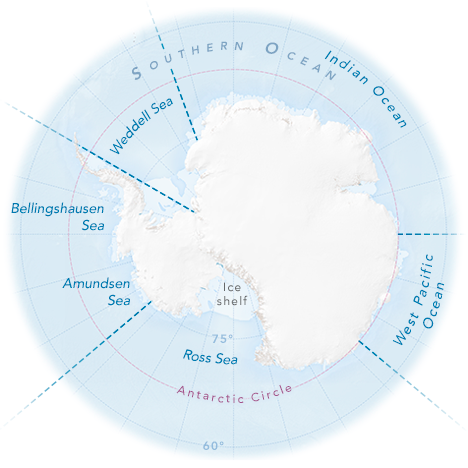
In the Southern Ocean, sea ice fringes the entire Antarctic continent. Researchers typically subdivide Antarctic sea ice into five sectors, each influenced by different geography and weather conditions. (NASA Earth Observatory map by Joshua Stevens, based on data from the Norwegian Polar Institute and Natural Earth.)
Antarctica experiences atmospheric oscillations and recurring weather patterns that influence sea ice extent. The primary variation is the Antarctic Oscillation, also called the Southern Annular Mode. Like the Arctic Oscillation, the Antarctic Oscillation involves a large-scale see-sawing of atmospheric mass between the pole and the mid-latitudes. This oscillation can intensify, weaken, or shift the location of low- and high-pressure weather systems. These changes influence wind speeds, temperature, and the track that storms follow, any of which may influence sea ice extent.
During positive phases of the Antarctic Oscillation, the prevailing westerly winds that circle Antarctica strengthen and move southward. This can change the way ice is distributed among the various sectors. The strengthening of the westerlies also isolates much of the continent and tends to have an overall cooling effect. However, it does cause dramatic warming on the Antarctic Peninsula, as warmer air above the oceans to the north is drawn southward. Winds may drive the ice away from the coast in some areas and toward the coast in others. Thus, the same climate influence may lessen sea ice in some sectors and increase it in others.
Changes in the El Niño-Southern Oscillation Index (ENSO), an oscillation of ocean temperatures and surface air pressure in the tropical Pacific, can lead to a delayed response (three to four seasons later) in Antarctic sea ice extent. In general, El Niño leads to more ice in the Weddell Sea and less ice on the other side of the Antarctic Peninsula, while La Niña causes the opposite conditions.
Another bit of atmospheric variability is the periodic strengthening and weakening of something meteorologists call “zonal wave three,” or ZW3. This pattern alternately strengthens winds that blow cold air away from Antarctica (toward the equator) and winds that bring warmer air from middle latitudes toward Antarctica. When southerly winds intensify, more cold air is pushed to lower latitudes, and sea ice tends to increase. The effect is most apparent in the Ross and Weddell Seas and near the Amery Ice Shelf.
As in the Arctic, the interaction of natural cycles is complex, and researchers continue to study how these forces interact and control the Antarctic sea ice extent.
In October 2015, Antarctic sea ice peaked for the year at 18.8 million square kilometers (7.3 million square miles). That’s smaller than the previous three years, but falls just about in the middle of maximum extents measured since 1979. By February 2016, just a small fraction of that ice remained, reaching an annual minimum extent of 2.6 million square kilometers (1 million square miles)—the ninth lowest in the satellite record.
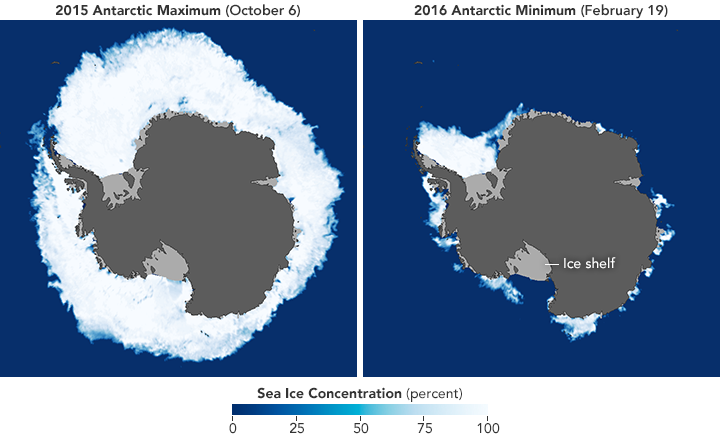
Since 1979, the total annual Antarctic sea ice extent has increased about 1 percent per decade. Compared to the Arctic, the signal has been a “noisy” one, with wide year–to-year fluctuations. For three consecutive Septembers (2012 to 2014), satellites observed new record highs for winter sea ice extent around Antarctica. The largest of those occurred in September 2014, when the ice reached 20.14 million square kilometers (7.78 million square miles). Still, increases in Antarctic sea ice are exceeded by decreases in the Arctic. That is to say, global sea ice is decreasing even as Antarctic sea ice is increasing slightly.
Unlike the Arctic, where the downward trend is consistent in all sectors, in all months, and in all seasons, the Antarctic picture is more complex. Although sea ice cover expanded in most of the Southern Ocean between 1979 and 2013, it decreased substantially in the Bellingshausen and Amundsen seas. These two seas are close to the Antarctic Peninsula, a region that has warmed significantly in recent decades.
The variability in Antarctic sea ice patterns in different sectors and from year to year makes it difficult to predict how Antarctic ice could change as greenhouse gases continue to warm the Earth. Climate models predict that Antarctic sea ice will respond more slowly than Arctic sea ice, but as temperatures continue to rise, a long-term decline is expected.

Why do the negative trends in Arctic sea ice seem to be more important to climate scientists than the increase in Antarctic ice? Part of the reason is that the size of the increase is much smaller and slightly less certain than the Arctic trend.
Another reason is that the complete summertime disappearance of Northern Hemisphere ice would be a dramatic departure from what has occurred throughout the satellite record and likely throughout recorded history. In the Antarctic, however, sea ice already melts almost completely each summer. Even if it completely disappeared in the summer, the impact on the Earth’s climate system would likely be much smaller than a similar disappearance of Arctic ice.
You might wonder how Antarctic sea ice could be increasing while global warming is raising the planet’s average surface temperature. It’s a question scientists are asking, too. One reason may be that other atmospheric changes are softening the influence of global warming on Antarctica. For example, the ozone hole that develops over Antarctica each spring actually intensifies a vortex of winds that circles the South Pole. The stronger this vortex becomes, the more isolated the Antarctic atmosphere becomes from the rest of the planet. In addition, ocean circulation around Antarctica behaves differently than it does in the Arctic. In the Southern Ocean, warm water tends to sink downward in the ocean’s water column, making sea ice melt from warm water less likely.

One concern related to Antarctic sea ice loss is how the relationship between land and sea ice will change. Ice shelves partly rest on land and partly float, and sea ice is thought to stabilize the edges of these shelves. Ice shelves frequently calve icebergs—a natural process that is not necessarily a sign of climate change. But the rapid disintegration and retreat of an ice shelf (such as the collapse of Larsen B in 2002) is a warming signal.
Although sea ice is too thin to physically buttress an ice shelf, intact sea ice may preserve the cool conditions that stabilize a shelf. Air masses passing over sea ice are cooler than air masses passing over open ocean. Sea ice may also suppress ocean waves that would otherwise flex the shelf and speed ice shelf breakup.
The interaction between sea ice loss and ice shelf retreat merits careful study because many ice shelves are fed by glaciers. When an ice shelf disintegrates, the glacier feeding it often accelerates. Because glacier acceleration introduces a new ice mass into the ocean, it can raise global sea levels. So while sea ice melt does not directly lead to sea level rise, it could contribute to other processes that do. Glacier acceleration has already been observed on the Antarctic Peninsula.
Because of differences in geography and climate, the amount, location, and natural variability of sea ice in the Arctic and the Antarctic are different. Global warming and natural climate patterns may affect each hemisphere’s sea ice in different ways or at different rates. Within each hemisphere, sea ice can change substantially from day to day, month to month, and even over the course of a few years.
Comparing conditions at only two points in time or examining trends over a short period is not sufficient to understand the impact of long-term climate change on sea ice. Scientists can only understand how sea ice is changing by comparing current conditions to long-term averages.
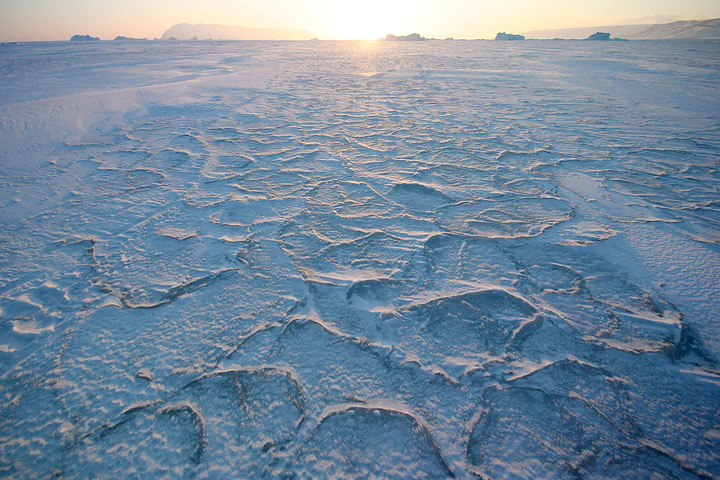
Since 1979, satellites have provided a consistent continuous record of sea ice. Through 2015, the average monthly September extent of Arctic sea ice has declined by 13.4 percent per decade relative to the average from 1981 to 2010. Declines are occurring in every geographic area, in every month, and every season. Natural variability and rising temperatures linked to global warming appear to have played a role in this decline. The Arctic may be ice-free in summer before the end of this century.
Antarctic sea ice trends are smaller and more complex. Relative to the average from 1981 to 2010, the Antarctic sea ice extent increased about 1 percent per decade, but the trends were not consistent for all areas or all seasons. The variability in Antarctic sea ice patterns makes it harder for scientists to explain Antarctic sea ice trends and to predict how Southern Hemisphere sea ice may change as greenhouse gases continue to warm the Earth. Climate models do predict that Antarctic sea ice will respond more slowly than Arctic sea ice to warming, but as temperatures continue to rise, a long-term decline is expected.